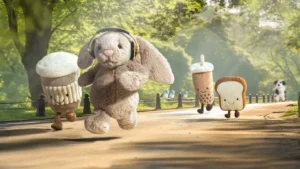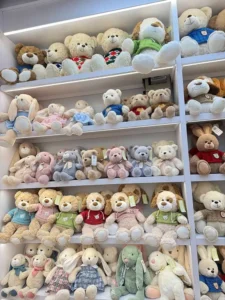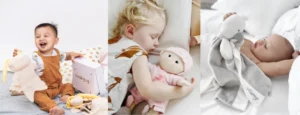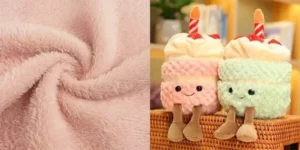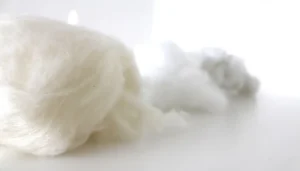When you think of plush toys, what comes to mind? Softness, comfort, and maybe a bit of nostalgia. But have you ever wondered what exactly makes these cuddly companions so irresistibly soft and durable? Choosing the right fabric for plush toys isn’t just about feeling good — it’s a complex decision involving safety, durability, cost, and even sustainability.
In short, plush toys are commonly made from fabrics like polyester, velboa, minky, fleece, and cotton blends. These materials balance softness, durability, and safety, making them ideal for a variety of plush toy styles and uses.
Imagine a child clutching their favorite teddy bear after a long day — the warmth and softness they feel is no accident. Behind that hug-worthy texture lies carefully selected fabric that meets strict safety standards while delivering the perfect tactile experience. Ready to dive into the world of plush toy fabrics? Let’s unravel what makes your favorite plushies so special.
1. What Are the Most Common Fabrics Used in Plush Toy Manufacturing?

Plush toys are primarily made from polyester-based fabrics such as velboa, minky, and fleece, prized for their softness and durability, with cotton blends occasionally used for specialty items.
Dive Deeper into Common Plush Fabrics
- Polyester: The Industry Staple Polyester is favored because it’s soft, durable, and cost-effective. It resists shrinking and maintains plushiness after multiple washes. Velboa, a short-pile polyester fabric, mimics fur and is often used for teddy bears. Minky fabric, with its ultra-soft, ultra-fine fibers, offers a luxurious feel, especially for baby toys. Fleece provides warmth and thickness, ideal for cuddly plushies with extra insulation.
- Cotton Blends: The Natural Option Cotton blends add breathability and a natural feel but can be less durable and prone to shrinking. They’re often reserved for organic or eco-friendly lines but require more careful maintenance.
- Fabric Selection Based on Use Cases Outdoor or washable plush toys often use fabrics treated for water resistance and stain protection. Collectible or fashion plushies might use specialty fabrics with unique textures or finishes, like velvet or velour.
- Comparing Fabric Performance
| Fabric Type | Softness | Durability | Washability | Cost | Typical Use Case |
|---|---|---|---|---|---|
| Polyester Velboa | Medium-High | High | Excellent | Low | Standard plush toys |
| Minky | Very High | Medium | Good | Medium | Baby toys, luxury plush |
| Fleece | High | Medium-High | Good | Low-Medium | Winter plushies |
| Cotton Blend | Medium | Medium | Variable | Medium-High | Organic or eco-friendly plush |
| Velvet / Velour | High | Medium | Variable | Medium-High | Collectible, fashion plush |
2. How Does Fabric Choice Affect Plush Toy Safety and Compliance?
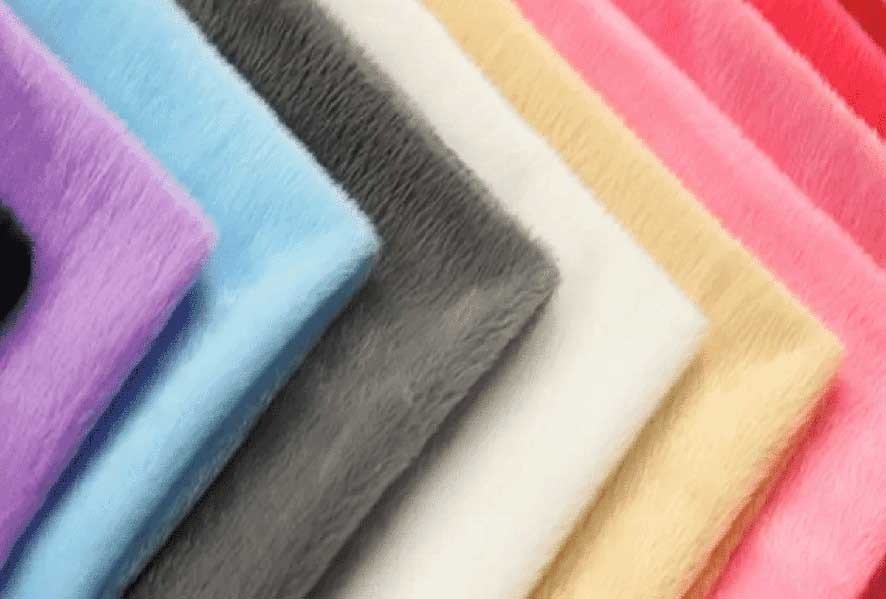
Fabric choice is critical to ensure plush toys meet safety standards; hypoallergenic, non-toxic fabrics that resist allergens are preferred, with rigorous testing for flammability and chemical safety.
| Aspect | Description | Examples/Standards |
|---|---|---|
| Toy Safety Regulations | Limits on toxic chemicals, flammability, allergenic substances in fabrics | ASTM F963 (USA), EN71 (Europe), ISO |
| Hypoallergenic Properties | Fabrics that resist dust mites and allergens, ideal for sensitive skin | Polyester-based fabrics |
| Fire Resistance and Flammability | Fabrics treated or selected to meet flammability safety standards | Flame retardant treatments |
| Chemical Treatments | Use of non-toxic dyes and finishes to ensure fabric safety | Compliance with chemical regulations |
| Quality Control (Kinwin Example) | In-house and third-party lab testing to ensure compliance with safety standards | Rigorous testing protocols |
Dive Deeper into Safety and Compliance
- Toy Safety Regulations and Fabric Requirements Regulations like ASTM F963 (USA), EN71 (Europe), and ISO standards set strict limits on toxic chemicals, flammability, and allergenic components in plush toy fabrics. Manufacturers select fabrics proven safe through certifications and testing.
- Hypoallergenic and Anti-Allergen Properties Fabrics that resist dust mites and allergens reduce risks, especially for babies and children with sensitive skin. Polyester-based materials, when properly processed, often exhibit hypoallergenic qualities.
- Fire Resistance and Flammability Plush toy fabrics must meet flammability standards. Treatments or fabric choices ensure that toys do not catch fire easily, protecting children from harm.
- Chemical Treatments and Safety Some fabrics undergo treatments for softness or durability, but chemicals used must comply with regulations. Non-toxic dyes and finishes are critical to avoid health risks.
- Case Example: Kinwin’s Quality Controls Kinwin rigorously tests all plush toy fabrics in-house and through third-party labs, ensuring all products meet or exceed global safety standards before shipment. Aspect Description Examples/Standards Toy Safety Regulations Limits on toxic chemicals, flammability, allergenic substances in fabrics ASTM F963 (USA), EN71 (Europe), ISO Hypoallergenic Properties Fabrics that resist dust mites and allergens, ideal for sensitive skin Polyester-based fabrics Fire Resistance and Flammability Fabrics treated or selected to meet flammability safety standards Flame retardant treatments Chemical Treatments Use of non-toxic dyes and finishes to ensure fabric safety Compliance with chemical regulations Quality Control (Kinwin Example) In-house and third-party lab testing to ensure compliance with safety standards Rigorous testing protocols
3. Which Fabrics Are Best for Different Plush Toy Applications and Styles?
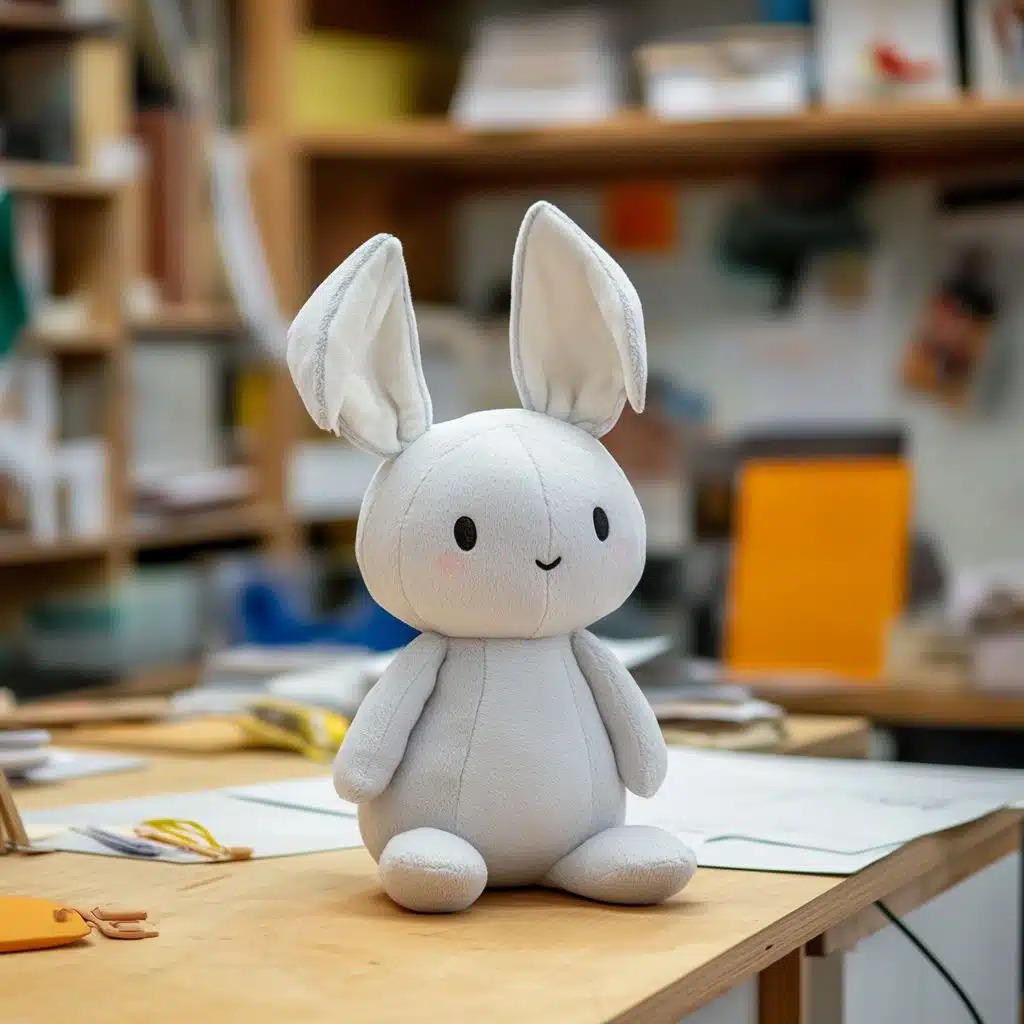
Different plush toy types require tailored fabric choices: soft minky for babies, durable velboa for kids, water-resistant polyester for outdoor toys, and specialty fabrics for collectible or fashion plush.
Dive Deeper into Fabric Application by Toy Type
- Baby Plush Toys Softness and safety top priorities — minky and fleece with hypoallergenic certifications are popular choices. Easy-care fabrics that withstand frequent washing are preferred.
- Kids’ Play Plush Toys Durability and washability matter. Velboa or treated polyester fabrics that can handle rough play and multiple washes without losing texture are favored.
- Outdoor Plush Toys Water-repellent and stain-resistant polyester fabrics ensure toys can survive outdoor conditions, dirt, and occasional rain.
- Collectible or Fashion Plush Toys Unique textures like velvet, velour, or specialty synthetics add visual appeal and exclusivity, often paired with delicate finishes. These toys prioritize aesthetics over durability.
- Custom and Cartoon Plush Bright, vivid polyester blends allow for vibrant colors and detailed designs, crucial for licensed character plushies. Plush Toy Type Recommended Fabrics Key Characteristics Typical Use Case Baby Plush Toys Minky, Fleece (hypoallergenic certified) Ultra-soft, safe, easy to wash Infant and toddler toys Kids’ Play Plush Toys Velboa, Treated Polyester Durable, washable, retains texture after rough play Everyday children’s toys Outdoor Plush Toys Water-repellent, Stain-resistant Polyester Weather-resistant, easy to clean Outdoor and garden plush toys Collectible/Fashion Plush Velvet, Velour, Specialty Synthetics Unique textures, aesthetic appeal, delicate finish Display and fashion plush collections Custom & Cartoon Plush Bright Polyester Blends Vivid colors, detailed printing capability Licensed character and promotional plushies
| Plush Toy Type | Recommended Fabrics | Key Characteristics | Typical Use Case |
|---|---|---|---|
| Baby Plush Toys | Minky, Fleece (hypoallergenic certified) | Ultra-soft, safe, easy to wash | Infant and toddler toys |
| Kids’ Play Plush Toys | Velboa, Treated Polyester | Durable, washable, retains texture after rough play | Everyday children’s toys |
| Outdoor Plush Toys | Water-repellent, Stain-resistant Polyester | Weather-resistant, easy to clean | Outdoor and garden plush toys |
| Collectible/Fashion Plush | Velvet, Velour, Specialty Synthetics | Unique textures, aesthetic appeal, delicate finish | Display and fashion plush collections |
| Custom & Cartoon Plush | Bright Polyester Blends | Vivid colors, detailed printing capability | Licensed character and promotional plushies |
4. Is Sustainability a Factor in Plush Toy Fabric Selection?

Yes, eco-conscious brands increasingly use recycled polyester, organic cotton, and biodegradable fibers to produce sustainable plush toys without sacrificing quality.
Dive Deeper into Sustainable Plush Fabrics
- Recycled Polyester: A Growing Trend Using PET bottles recycled into polyester fibers reduces plastic waste and carbon footprint. These fabrics offer similar softness and durability to virgin polyester.
- Organic Cotton and Natural Fibers Organic cotton grown without harmful pesticides appeals to environmentally conscious buyers but can be more expensive and less durable.
- Biodegradable and Bio-Based Fibers Innovations in PLA (polylactic acid) fibers and other bio-based textiles promise compostability, though cost and durability challenges remain.
- Balancing Sustainability with Performance and Cost Eco-friendly fabrics sometimes require trade-offs in softness or price. Manufacturers often blend sustainable and conventional fibers to optimize both.
- Market Example: Kinwin’s Eco Line Kinwin offers plush toys made from GRS-certified recycled polyester, ensuring traceability and sustainability from raw material to finished product. Sustainability Factor Description Advantages Challenges/Considerations Recycled Polyester Made from recycled PET bottles, reduces plastic waste and carbon footprint Softness and durability similar to virgin polyester Requires reliable recycling supply chains Organic Cotton & Natural Fibers Grown without harmful pesticides, appeals to eco-conscious consumers Natural, breathable, eco-friendly Higher cost, less durable than synthetics Biodegradable & Bio-Based Fibers Includes PLA fibers offering compostability Environmentally friendly, reduces landfill waste Costly, durability and performance still improving Balancing Sustainability & Cost Blending sustainable with conventional fibers to optimize softness, durability, and price Cost-effective, performance balanced Requires careful formulation Kinwin’s Eco Line Plush toys made with GRS-certified recycled polyester ensuring traceability and sustainability Certified, sustainable, high-quality Market education and demand building
| Sustainability Factor | Description | Advantages | Challenges/Considerations |
|---|---|---|---|
| Recycled Polyester | Made from recycled PET bottles, reduces plastic waste and carbon footprint | Softness and durability similar to virgin polyester | Requires reliable recycling supply chains |
| Organic Cotton & Natural Fibers | Grown without harmful pesticides, appeals to eco-conscious consumers | Natural, breathable, eco-friendly | Higher cost, less durable than synthetics |
| Biodegradable & Bio-Based Fibers | Includes PLA fibers offering compostability | Environmentally friendly, reduces landfill waste | Costly, durability and performance still improving |
| Balancing Sustainability & Cost | Blending sustainable with conventional fibers to optimize softness, durability, and price | Cost-effective, performance balanced | Requires careful formulation |
| Kinwin’s Eco Line | Plush toys made with GRS-certified recycled polyester ensuring traceability and sustainability | Certified, sustainable, high-quality | Market education and demand building |
5. How Do Manufacturers Balance Softness, Durability, and Cost in Fabric Selection?

Manufacturers use fabric blends, finishing techniques, and bulk sourcing to deliver soft, durable plush toys while controlling costs to meet market demands.
Dive Deeper into Manufacturing Strategies
- Fabric Blends for Optimized Performance Combining polyester with cotton or rayon enhances softness without sacrificing durability or raising costs excessively.
- Finishing Techniques Brushing, shearing, calendaring, and special coatings improve softness and fabric hand feel post-production.
- Automation and Quality Control Modern knitting and weaving machines ensure consistent fabric density and quality, reducing waste and cost.
- Bulk Purchasing and Supplier Relationships Strategic sourcing lowers raw material prices. Long-term partnerships with suppliers guarantee fabric quality and supply stability.
- Cost vs. Quality Trade-offs Entry-level toys prioritize cost-effectiveness with standard velboa, while premium lines invest in luxury minky or organic fabrics.
- Example: Kinwin’s Approach Kinwin balances cost and quality by offering tiered product lines and leveraging advanced fabric treatments to maintain softness at scale. Manufacturing Strategy Description Benefits Considerations Fabric Blends Combining polyester with cotton or rayon to optimize softness and durability Improved softness without high cost Blend ratios must be carefully balanced Finishing Techniques Processes like brushing, shearing, calendaring, and coatings enhance softness and feel Enhanced tactile quality Adds production steps and cost Automation & Quality Control Use of advanced knitting/weaving machines ensures consistent fabric quality Reduced waste, consistent product quality Initial equipment investment required Bulk Purchasing & Supplier Partnerships Strategic sourcing to lower raw material costs and ensure stable supply Cost savings and quality assurance Dependence on supplier reliability Cost vs. Quality Trade-offs Balancing affordable standard fabrics for entry-level toys with premium materials for luxury Meets different market segments Market demands influence material choice Kinwin’s Approach Tiered product lines and advanced fabric treatments to maintain softness at scale Flexibility in pricing and quality Requires expertise in fabric technology
| Manufacturing Strategy | Description | Benefits | Considerations |
|---|---|---|---|
| Fabric Blends | Combining polyester with cotton or rayon to optimize softness and durability | Improved softness without high cost | Blend ratios must be carefully balanced |
| Finishing Techniques | Processes like brushing, shearing, calendaring, and coatings enhance softness and feel | Enhanced tactile quality | Adds production steps and cost |
| Automation & Quality Control | Use of advanced knitting/weaving machines ensures consistent fabric quality | Reduced waste, consistent product quality | Initial equipment investment required |
| Bulk Purchasing & Supplier Partnerships | Strategic sourcing to lower raw material costs and ensure stable supply | Cost savings and quality assurance | Dependence on supplier reliability |
| Cost vs. Quality Trade-offs | Balancing affordable standard fabrics for entry-level toys with premium materials for luxury | Meets different market segments | Market demands influence material choice |
| Kinwin’s Approach | Tiered product lines and advanced fabric treatments to maintain softness at scale | Flexibility in pricing and quality | Requires expertise in fabric technology |
6. What Trends Are Emerging in Plush Toy Fabrics and Material Technology?
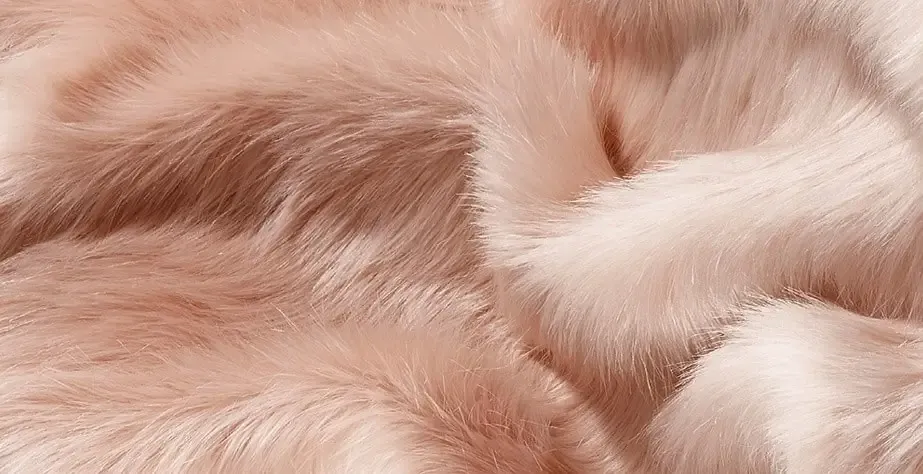
Emerging trends include smart textiles with antimicrobial properties, recycled and bio-based fibers, and fabric innovations enhancing sustainability and sensory experiences.
Dive Deeper into Plush Fabric Innovations
- Antimicrobial and Antibacterial Treatments Adding antimicrobial agents to fabrics helps keep plush toys hygienic and odor-free, especially for baby products.
- Smart Textiles and Interactive Fabrics Sensors and conductive threads embedded in plush fabrics open new possibilities for interactive toys.
- Enhanced Sustainability Innovations New biodegradable fibers and closed-loop recycling methods improve plush toy environmental impact.
- Sensory Textures and Multi-Fabric Designs Mixing different fabric textures enhances tactile stimulation, beneficial for developmental toys.
- Market Adaptation Leading manufacturers like Kinwin actively incorporate these innovations, aligning with evolving consumer demands and regulatory landscapes. Emerging Trend Description Benefits Industry Impact Antimicrobial & Antibacterial Fabrics treated with agents to prevent bacteria growth and odors Improved hygiene, especially for babies Increased safety and consumer appeal Smart Textiles & Interactive Fabrics Integration of sensors and conductive threads for interactive features New play experiences, educational value Expands toy functionality Enhanced Sustainability Use of biodegradable fibers and closed-loop recycling methods Reduced environmental footprint Supports eco-conscious market growth Sensory Textures & Multi-Fabric Designs Combining varied textures to enhance tactile stimulation Developmental benefits, sensory engagement Broadens toy design possibilities Market Adaptation Manufacturers like Kinwin adopt new technologies to meet consumer and regulatory demands Competitive advantage and compliance Drives innovation and market leadership
| Emerging Trend | Description | Benefits | Industry Impact |
|---|---|---|---|
| Antimicrobial & Antibacterial | Fabrics treated with agents to prevent bacteria growth and odors | Improved hygiene, especially for babies | Increased safety and consumer appeal |
| Smart Textiles & Interactive Fabrics | Integration of sensors and conductive threads for interactive features | New play experiences, educational value | Expands toy functionality |
| Enhanced Sustainability | Use of biodegradable fibers and closed-loop recycling methods | Reduced environmental footprint | Supports eco-conscious market growth |
| Sensory Textures & Multi-Fabric Designs | Combining varied textures to enhance tactile stimulation | Developmental benefits, sensory engagement | Broadens toy design possibilities |
| Market Adaptation | Manufacturers like Kinwin adopt new technologies to meet consumer and regulatory demands | Competitive advantage and compliance | Drives innovation and market leadership |
Ready to Elevate Your Plush Toy Line?
If you’re looking to source premium, safe, and eco-friendly plush fabrics for your next collection, Kinwin is your trusted partner. With advanced production equipment, strict quality control, and cutting-edge fabric innovation, we tailor solutions that meet your unique market needs. Contact Kinwin today to customize plush toys that delight customers and comply with the highest standards




